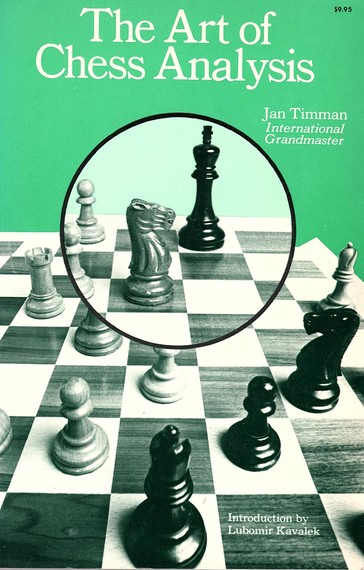
Chess Champions and Their Queens (2)
By GM Lubomir Kavalek

Timman was under the influence of Mikhail Botvinnik’s advice to publish his analysis and to create an analytical debate. He found space in the Dutch magazine Schaakbuletin, founded by Wim Andriessen in 1968.
It was a year of great hopes and disappointments in Czechoslovakia. The Prague Spring, when the Czechs found the freedom to think, speak and write, impacted my chess and I started to have good, consistent results. I finished narrowly behind the winners in Sarajevo, won the all-time strongest Czechoslovakian championship and was able to stay in step with two legends: I won in Amsterdam ahead of Bronstein, but the former world champion Vassily Smyslov edged me in Polanica Zdroj. During the second tournament, the Soviet-led Warsaw pact armies invaded Czechoslovakia and in September I left the country for good.
In November 1968, I won in the Hague, playing Timman for the first time. He was 17, an emerging chess master with plenty of love for the game. I watched his progress as chessplayer and writer with interest. In 1975, when he advertised his queen sacrifice in his writing, he was already a solid grandmaster getting stronger by the day.


[Event "Amsterdam "] [Site "Amsterdam"] [Date "1975.??.??"] [Round "?"] [White "Timman, Jan H"] [Black "Kavalek, Lubomir"] [Result "0-1"] [ECO "B99"] [Annotator "GM Lubomir Kavalek/The Huffington Post"] [SetUp "1"] [FEN "r1b1k2r/1pq1bpp1/pn1ppn1p/6B1/3NPP2/2NB3Q/PPP3PP/2KR3R w kq - 0 12"] [PlyCount "44"] [EventDate "1975.??.??"] [EventType "game"] [EventCountry "NED"] 12. Bh4 $6 {This retreat leads to a Queen sacrifice.} ({Discouraged by this game, Timman later in the tournament tried} 12. f5 e5 13. Nb3 Bd7 14. Be3 $1 { against the Dane Svend Hamman. He won the fight for the control of the d5 square and booked a victory in 29 moves.}) 12... e5 13. Nf5 g6 $5 $146 {[#]} ({ A novelty at that time. Walter Browne against Timman (Wijk aan Zee 1975 and later Lajos Portisch against Planinc (Ljubljana-Portoroz 1975) played} 13... Bxf5 {and both lost. After the text move White is forced to sacrifice his Queen. Of course, Timman knew that I knew about this move, since we briefly discussed it together in Wijk aan Zee, but we did not reach a clear conclusion. Reaching this position, I remembered my conversation with my friend Milan Vukcevich at the U.S. Championship in Oberlin. Milan tried to convince me that the Queen sacrifice is incorrect.}) 14. Nxe7 $6 {The Queen sacrifice is tempting since in the follow up more white pieces are being offered.} ({ Some computers suggest} 14. Rhe1 gxf5 15. exf5 Kf8 $15) 14... Bxh3 15. Bxf6 Be6 $1 {Black needs to control the square d5.} (15... Bg4 $2 16. Ned5 $16) 16. f5 Rf8 $5 {Stronger than} (16... gxf5 17. exf5 Bd7 18. Be4 Rf8 19. Ned5 Nxd5 20. Nxd5 Qa5 21. Nc3 $11) 17. Bb5+ $6 {This looks pretty, but grabbing the Bishop first was more prudent:} (17. fxe6 $1 fxe6 18. Bb5+ $1 axb5 $5 19. Nxb5 Qc5 20. Nxd6+ Qxd6 21. Rxd6 Nc4 $1 {Black is better, but White can still fight.}) 17... Bd7 $1 {The best.} (17... axb5 $6 18. Nxb5 Qxe7 19. Bxe7 Kxe7 20. fxe6 Nc4 $11) 18. Ned5 Nxd5 19. Nxd5 {This is still Timman's analysis.} Qa5 $1 {This should win for Black, but it is not simple.} ({Timman wrote that after} 19... Qc5 $2 20. b4 $1 {White wins, for example} Qc8 21. Nb6 $18) ({Also after} 19... Qb8 20. Bxd7+ Kxd7 21. Rd3 {Black's heavy pieces are somehow paralyzed and the chances are unclear.}) 20. Bxd7+ Kxd7 {The material is reduced and Black has more light squares for his Queen.} 21. a4 {Played after about 15 minutes. White is threatening to win the queen with 22.b4 and Black must allow his Queenside to be tied up.} Qc5 $1 22. b4 Qc6 23. a5 {Timman was eager to create an outpost on b6, but it gives Black a time to counter.} ({Black should be winning also after} 23. Rhf1 Rac8 24. Rd2 Rg8 $19) 23... gxf5 $1 24. exf5 Rg8 { [#] Black finally found an open file for the Rook.} 25. Nb6+ Ke8 $1 {Leaving the Rook on a8 unprotected surprised Timman. He was counting mainly on 25... Kc7, but the text move is stronger: Black begins offensive operations.} ({ White has chances to fight after} 25... Kc7 26. Nd5+ Kb8 $2 27. Ne7 Qc3 (27... Qxg2 28. Nxg8 Qxg8 29. Rxd6 Ka7 $11) 28. Nxg8 Qa3+ 29. Kd2 Qxb4+ 30. Kc1 $11) 26. g3 ({The fans did not like this move and preferred} 26. g4 $5 {but Black has a decisive attack after} Qc3 $1 27. Nxa8 (27. h3 Rb8 $19) 27... Qa3+ 28. Kd2 Rxg4 $19) ({Black also wins after} 26. Nxa8 $2 Rxg2 27. Rd2 Rxd2 28. Kxd2 Qxh1 $19) ({Or after} 26. Rhg1 Rg4 27. Nxa8 Rc4 28. Rd2 Qa4 {wins.}) 26... Rg4 $1 $19 {[#] Not wasting time to escape with the Rook on a8. The Queen and the Rook work harmoniously together.} 27. Rhe1 ({After} 27. Nxa8 Rc4 {the white king is defenseless, although Black has to be careful:} 28. Rhe1 Rxc2+ 29. Kb1 Qc4 $1 ({But not} 29... Qc3 $2 30. Rxe5+ $1 Kf8 31. Re8+ Kxe8 32. Bxc3 $18) 30. Rxe5+ Kf8 {and Black mates soon.}) 27... Rb8 28. Bxe5 {Equivalent to resignation, but White really has not much choice.} (28. Rxd6 Qxd6 29. Bxe5 Qxb4 30. Bc3+ Qe4 $19) (28. Rd3 Rxb4 29. Bxe5 dxe5 30. Rxe5+ Kf8 31. Nd7+ Kg7 32. Nxb8 Qg2 33. Nd7 Rc4 $19) 28... dxe5 29. Rxe5+ Kf8 30. Nd7+ Kg7 31. f6+ Kh7 32. Nxb8 Qc3 $1 33. Rdd5 (33. Re7 Qa1+ 34. Kd2 Rd4+ $19) 33... Rd4 $1 ({ The final touch, threatening 34...Qa1 mate. Black now gobbles up both Rooks after} 33... Rd4 $1 34. Rxd4 Qa1+ 35. Kd2 Qxd4+ 36. Kc1 Qxe5 $19) 0-1
In 1984, with the injection of money from the publisher Elsevier, Andriessen turned his magazine into an English publication New In Chess and Timman became editor-in-chief.
Timman’s sacrifice didn’t turn out as he hoped. Today, it could have been checked by analytical engines beforehand. I don’t think Timman considered computers friendly creatures. He was proud to invent ideas on his own.
But computers are here to stay as part of hybrid man-machine preparation. The entertaining queen sacrifice in the game Caruana-Nakamura, from London last month, is a good example. Nakamura tweaked computer analysis, but it backfired. Caruana’s two minor pieces became stronger than the queen.


[Event "8th London Classic "] [Site "?"] [Date "2016.??.??"] [Round "?"] [White "Caruana, Fabiano"] [Black "Nakamura, Hikaru"] [Result "1-0"] [ECO "B96"] [WhiteElo "2823"] [BlackElo "2779"] [Annotator "GM Lubomir Kavalek/The Huffington Post"] [PlyCount "63"] [EventDate "2016.12.07"] 1. e4 c5 2. Nf3 d6 3. d4 cxd4 4. Nxd4 Nf6 5. Nc3 a6 6. Bg5 e6 7. f4 h6 8. Bh4 Qb6 9. a3 Be7 10. Bf2 Qc7 11. Qf3 Nbd7 12. O-O-O b5 13. g4 g5 14. h4 gxf4 15. Be2 b4 $2 {Nakamura plays a new move, injecting a pawn sacrifice.} ({After the immediate} 15... Ne5 16. Qxf4 Nexg4 17. Bxg4 e5 {he wants to prevent} 18. Nd5 $5 ({The Queen sacrifice} 18. Qxf6 Bxf6 19. Nd5 Qd8 20. Nf5 {is possible and leads to a roughly equal game. It has been known for several months.}) 18... Nxd5 19. Qf3 $1 {[#] with White's edge, for example} Bxg4 20. Qxg4 Nf6 21. Qf3 exd4 22. Bxd4 $16) 16. axb4 Ne5 17. Qxf4 Nexg4 18. Bxg4 e5 19. Qxf6 $3 { The Queen sacrifice is the only right way to continue and Caruana gets an extra pawn.} ({After} 19. Nd5 $2 Nxd5 20. Qf3 Nxb4 {Black has an almost decisive advantage.}) 19... Bxf6 20. Nd5 Qd8 {[#]} 21. Nf5 $1 {This powerful plug, threatening 22.Bb6, is the best move. Two minor pieces for the Queen provide great compensation. White dominates the light squares and open files. There are several variations supporting this view. Nakamura tricked himself or the computer did it. In either case it was a sad ending for his opening preparation.} Rb8 ({After} 21... Bxf5 22. Bxf5 Rb8 {White can create dangerous threats by marching his c-pawn:} 23. c4 O-O 24. c5 $1 $18) 22. Nxf6+ Qxf6 23. Rxd6 {A human touch.} ({The computers prefer the more forcing} 23. Nxd6+ Ke7 ( 23... Kf8 24. Bf5 $18) 24. Bc5 $1 Qf4+ (24... Bxg4 25. Nb5+ Ke6 26. Nc7#) 25. Kb1 Qxg4 26. Nxc8+ Ke8 27. Nd6+ Ke7 28. Nf5+ Ke8 29. Rhg1 {threatening 30.Ng7+, White should win.}) 23... Be6 24. Rhd1 O-O {[#]} ({After} 24... Rxb4 25. Rxe6+ fxe6 26. Bh5+ Kf8 27. Bc5+ {wins.}) 25. h5 $1 {A beautiful move, preparing 26. Bh4 to chase the black Queen to the corner square h8.} Qg5+ (25... Rxb4 26. Bh4 Bxf5 27. Bxf6 Bxg4 28. Re1 $16) 26. Be3 Qf6 27. Nxh6+ Kh8 28. Bf5 Qe7 $6 { Loses on the spot, but other moves do not save Black either:} (28... Qh4 29. Rg1 Qxh5 30. Rdd1 Qf3 31. Rde1 $18) (28... Rfe8 29. Rg1 $18) 29. b5 $6 ({ The immediate} 29. Nxf7+ $1 Qxf7 30. Rxe6 {would have been more powerful and quicker.}) 29... Qe8 30. Nxf7+ Rxf7 31. Rxe6 Qxb5 32. Rh6+ (32. Rh6+ Kg7 33. Rg1+ Kf8 34. Rh8+ Ke7 35. Rxb8 Qxb8 36. Bc5+ $18) 1-0
|

You probably know that you can move pieces on the replay board to analyse, and even start an engine to help you. You can maximize the replayer, auto-play, flip the board and even change the piece style in the bar below the board. At the bottom of the notation window on the right there are buttons for editing (delete, promote, cut lines, unannotate, undo, redo) save, play out the position against Fritz and even embed our JavaScript replayer on your web site or blog. Hovering the mouse over any button will show you its function. |
Images from London Chess Classic and SachInfo
Original column here – Copyright Huffington Post

The Huffington Post is an American news website and aggregated blog founded by Arianna Huffington and others, featuring various news sources and columnists. The site was launched on May 9, 2005, as a commentary outlet and liberal/progressive alternative to conservative news websites. It offers coverage of politics, media, business, entertainment, living, style, the green movement, world news, and comedy. It is a top destination for news, blogs, and original content. The Huffington Post has an active community, with over over a quarter of a billion visits per month (according to Quantcast), making it the number 73 ranked web site in the world (Alexa, January 2014).






























